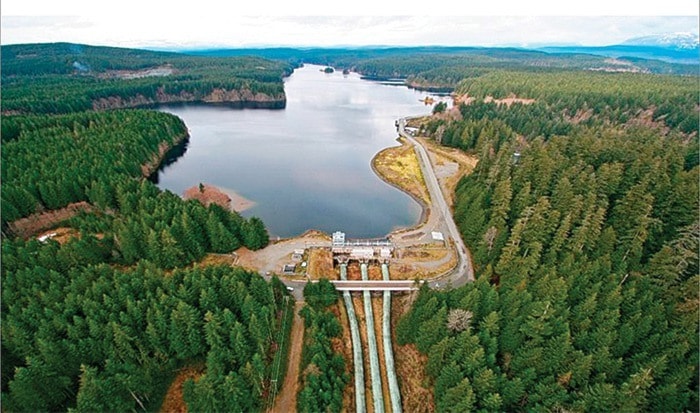Seismic upgrades on the John Hart Dam, which could begin in three years, may potentially affect the city’s drinking water, says BC Hydro.
Stephen Watson, spokesperson for BC Hydro, said the work will to some extent alter the water quality in the John Hart reservoir where the city draws its drinking water from.
“We need to draw down the reservoir about 10 metres in order to do this work,” Watson told city council at its Dec. 12 meeting. “One of the main things we’re looking at right now is a water quality study. We’re looking to get the results of that in early 2017 to see what that might do to water quality in the John Hart reservoir and (it) will help guide the project.”
Watson said BC Hydro will ensure that water quality is protected.
“Hydro will put a lot of measures in place to protect water quality, such as silt curtains,” Watson said. “The study will help us identify that if an issue does arise, how do we mitigate it.”
Coun. Larry Samson was concerned about Campbell River having to enforce boil water advisories, similar to what happens in parts of the Comox Valley after a significant rainfall.
“Are we going to see a change and I’m thinking of the Comox Valley and the turbidity problem they have,” Samson said.
“The answer is, ‘we don’t know yet,’ so that’s why we have this Water Technical Committee,” Watson said.
He said the City of Campbell River, Island Health, and other government agencies all sit on the committee as do consultants who are analyzing similar scenarios in other geographical areas where reservoirs have been drawn down.
“Once we have that information that will help us guide the project as it moves along,” Watson said.
The project is aimed at making the John Hart Dam, which was built in 1947, strong enough to withstand a one in 10,000 year earthquake. Hydro intends to implement a significant upstream berm, as well as a passive spillway at the dam so that when reservoir levels rise, water will naturally free-spill over that area.
Watson said BC Hydro still needs regulatory approval from the BC Utilities Commission to do the work. The commission is an independent body that regulates BC Hydro and Fortis BC and reviews rates on behalf of ratepayers. Watson said Hydro plans to put the project before the commission for approval in early 2019 so construction can start in 2020.
Following the John Hart Dam project, Hydro intends to begin work on the Strathcona Dam which was built in 1958, is the furthest dam up the Campbell River and is where about 80 per cent of the water inflows enter the system.
Key to the project is construction of a tunnel – a low-level outlet to go deep into the reservoir to be able to draw water levels down post-earthquake.
“The spillway gates are quite high up in the reservoir and they’re unable to lower the reservoir very much,” Watson said. “So with this low-level outlet, that tunnel allows us to have that capability.”
Watson said that long-term Hydro is thinking of replacing the powerhouse at Strathcona but the first step is to get the new gate in place.
He added that the utility is in the middle of developing five different construction concepts for Strathcona Dam, with an eye to developing the final option this coming summer and moving into construction in 2020.
In the meantime, work continues on the John Hart Generating Station Replacement project, which is expected to wrap up in the fall of 2018.
Hydro is also continuing work at the 7th Avenue substation which is expected to be complete by the end of 2017. That project involves the addition of another transformer and a couple of additional circuits to add capacity and accommodate growth.
Like the two dams, seismic work is also being done. Watson said a geotechnical study done on the substation revealed that the north slope could “slump or fail in the event of an earthquake” so Hydro is “shoring that up.”
Hydro will also be busy next year with the Salmon River Diversion project.
The utility is currently awaiting approval from the BC Utilities Commission to remove the diversion dam on the river.
“We’re looking forward to that process and are hoping to remove that dam to provide unhindered fish passage upstream and downstream for fall of 2017,” Watson said. “We have to do it in the Fisheries window, which is in the summertime so we’ll hopefully have that in place.”
